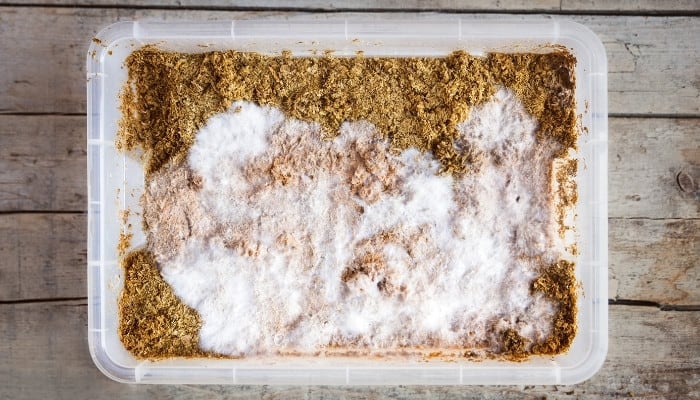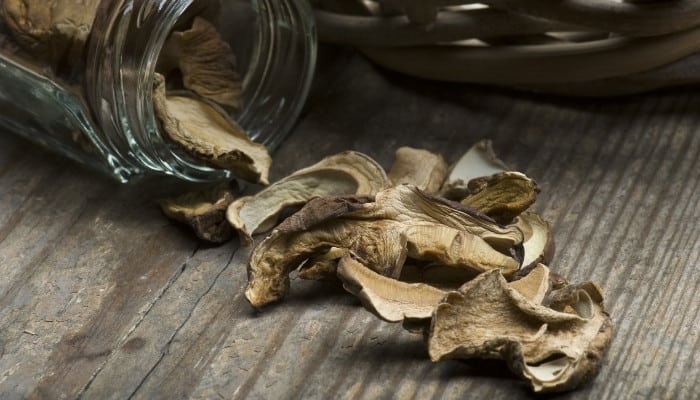Mushrooms do not germinate from seeds or bulbs like typical food crops; they propagate from spores instead.
The spores in mushrooms that have been dried out using various techniques like dehydrators or excessive exposure to direct sunlight are dead and will not grow new mushrooms.
Can you grow mushrooms from dried mushrooms? Despite popular consensus that claims you can’t grow mushrooms from dried mushrooms, the truth is that you can. If you expose the mushrooms to temperatures of more than 150°F, you won’t be able to use them, but with the right drying technique, you can dry mushrooms and use them to grow more.
In the following, you’ll learn everything you need to know about growing mushrooms from dried mushrooms.
As you’re probably aware, it is critical to correctly determine any mushroom species you plan on consuming. I highly recommend this mushroom field guide.
It’s packed with information, easy to navigate, and full of images to help with identification.
I love that similar mushrooms are grouped together so you’re not forced to flip through hundreds of pages to find what you need.
3 Factors That Determine Success When Using Dried Mushrooms
Growing mushrooms from dried mushrooms isn’t the most common practice, but it is one carried about by scores of mushroom lovers every year.
The following factors are among the most important if you want to have a successful crop of mushrooms from the spores of dried mushrooms.
Type of Mushroom
The type of mushroom that you use when growing mushrooms from dried mushrooms is crucial as not all species are suitable.
Once dried out, certain species of mushrooms don’t rehydrate as well as others.
Likewise, some types of mushrooms are more fragile than others and are less heat resistant (meaning, their spores are destroyed when exposed to lower temperatures than other mushrooms).
Dehydration Method
The dehydration method that you use for growing mushrooms from dried specimens is also extremely important.
For example, if you dry your mushrooms in the open air and sunlight, the heat from the sun may be enough to kill the spores.
Likewise, dehydrators may expose the mushroom spores to excessive temperatures that their spores can’t survive.
The best method for dehydrating mushrooms that you plan to use for growing fresh specimens is air drying them at room temperature.
A tabletop or shelf is the perfect location. A windowsill with indirect sunlight works well. Just make sure to flip the mushrooms from side to side as needed to help the natural drying process along.
How Long the Mushrooms Have Been Dried
Mushroom spores last for years, right? Well, technically, yes they do, but that’s when they’re in the ground as nature intended.
If you want to use your dried mushrooms for growing batches of new ones they need to be utilized within 12 months of drying and storing them.
Waiting longer than a year to rehydrate and/or take spore prints from dried mushrooms is a gamble.
Mushrooms that have been dried are best used within 6 to 12 months, whether for eating or growing more.
How To Grow Mushrooms From Dried Mushrooms

Growing mushrooms from dried mushrooms is a straightforward practice, just follow the steps below.
Before getting started, keep in mind that you need clean tools and a sterile workspace when dealing with mushrooms.
1. Rehydrate Mushrooms
The first step to growing mushrooms from dried mushrooms is to rehydrate them.
The easiest way to do so is by spreading the mushrooms out on a flat surface and dripping one or two drops of water onto each cap.
Using an eyedropper is highly suggested as it doesn’t take more than an extra drop or two of water to potentially ruin or wash away precious spores.
2. Collect Spores
Once your mushrooms are rehydrated, carefully remove the caps from the stems.
Take the cap of the mushroom and place it on a sheet of paper (you can trim them down into small squares before or after making the spore prints).
Either fold the paper over, sandwiching the cap, or add a second sheet of paper on top of the mushroom cap. Place a book with a bit of weight (or something similar) directly on top of the cap.
Wait 24 to 48 hours and remove the weight. Your paper will now have a fresh spore print ready for use.
3. Add Spores to Growing Medium
The next step is really a couple of steps in one: First, you need to set up a proper growing medium, and then you need to inject spores into it.
You may do so by using a growing tray or fruiting chamber that measures several inches deep (at least 4 to 6 inches), and 12 inches by 12 inches in size (or larger).
Fill the tray with a mushroom substrate or a homemade mixture of organic compost and manure. Leave only an inch or so of the pan empty.
Directly on the top of the growing medium, spread the spore from the spore print. A knife tip or X-Acto knife works well for scraping the spores off of the paper.
Be sure to keep everything clean and sterile; otherwise, mold and other bacteria may pop up instead of (or with) your new mushrooms.
Also, keep the growing medium moist at all times. If it dries out, the entire process grinds to a halt.
4. Incubate Spores
If you’ve followed the instructions above, the next step is upkeeping the future colony of mushrooms while the spores incubate.
Simply keep things moist and the temperature at around 70°F degrees.
The combination of water, nutrients from the growing medium, and warm temperatures are the magic recipe for mushroom growth.
After the first 3 weeks or so, the temperature should be reduced to approximately 55 to 60°F and left there for the rest of the operation.
When you lower the temperature, you also need to cover the mushroom mycelium with soil (just fill the empty inch or so of space you left).
Once covered with soil, the silky white mycelium should begin to produce tiny pin-like mushrooms.
Three or four weeks later, those little pins are fully developed mushrooms ready to pick and devour, dehydrate, or do whatever else you might have planned for them.
Related Questions:
Is It Illegal To Grow Psilocybe Mushrooms?
Only mushrooms with psilocybin and psilocin are considered illegal in most states where mushrooms are prohibited. The punishment, if there is one, is usually up to the judge’s view of the local mushroom laws.
The main reason you’ll get in trouble is for having enough that it appears to be for distribution.
Can You Make Liquid Culture From Dried Mushrooms?
It is possible to make a liquid culture from dried mushrooms, but you need to be extra careful when you are attempting it.
Wet the cap by putting a drop or two of water on it, and then cover it with a glass jar and leave it alone for around a day.
That way the spores may fall off onto whatever it is you want to collect the spores on – naturally, in this case, liquid.
A Final Word About Growing Mushrooms From Dried Mushrooms
Growing mushrooms from dried mushrooms takes a bit of practice, but with patience it can be done.
Just keep in mind that there are a lot of variables to consider, like what type of mushrooms you’re dealing with, how long they’ve been dried, the health of the spores, and more.

